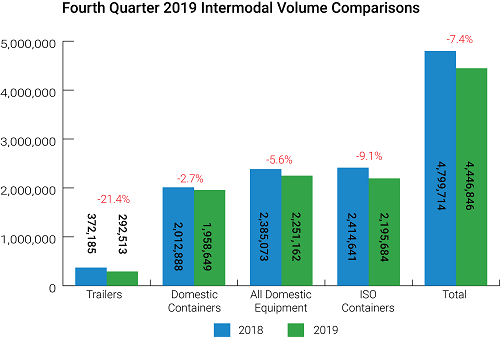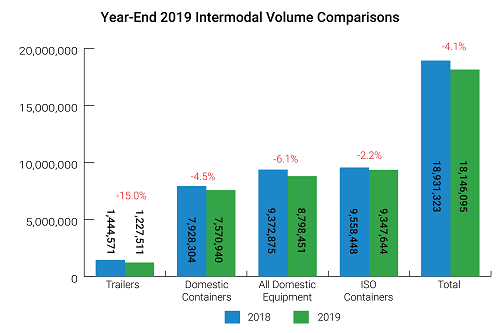Intermodal finishes the fourth quarter down
Feb 06, 2020Total intermodal volumes dropped 7.4 percent year-over-year in the fourth quarter of 2019, according to the Intermodal Association of North America’s Intermodal Market Trends & Statistics report. Domestic containers fell 2.7 percent from 2018; international shipments, 9.1 percent; and trailers, 21.4 percent.

“We haven’t seen full-year declines like these since the 2009 recession. Looser trucking capacity played a role on the domestic side of intermodal, while tariffs and tough comparisons to 2018 volumes affected international,” said Joni Casey, president and CEO of IANA. “A comeback could be hastened by a number of factors, including further resolution to trade issues, but it’s difficult to predict that timing.”
The seven highest-density trade corridors, which collectively handled 67.7 percent of total volume, were down 7.2 percent in the fourth quarter. Two recorded double-digit losses: the Midwest-Northwest at 15.8 percent and the South Central-Southwest at 13.0 percent. The negative numbers for the remaining corridors were more moderate: the Midwest-Southwest at 5.7 percent; the Northeast-Midwest, 5.7 percent; the Trans-Canada, 4.7 percent; the Intra-Southeast, 4.4 percent; and Southeast-Southwest, 3.4 percent.

Total IMC volume fell 8.4 percent year-over-year in Q4, with intermodal and highway loads both down. Full year volume declined 7.8 percent.
Similar Stories
INVESTING IN AMERICA: Biden-Harris Administration announces $635 Million to continue expanding zero-emission EV charging and refueling infrastructure
New investments from the Bipartisan Infrastructure Law will add more than 11,500 electric vehicle charging ports and expand hydrogen and natural gas fueling infrastructure in communities nationwide
View Article
Consolidated Chassis Management expands leadership team with four key hires
View Article
CMA CGM Brazil enhances its intermodal sustainable solutions
View Article
AAR reports rail traffic for the week ending January 04, 2025
View Article
ATDA members vote to ratify national agreement with NCCC
View Article
Savage Wellington Transload Terminal to provide Utah crude-by-rail connection
View ArticleGet the most up-to-date trending news!
SubscribeIndustry updates and weekly newsletter direct to your inbox!





